Holly K. Peralta, Credentialed English Teacher
Teaching Students
the Art of Language
the Art of Language


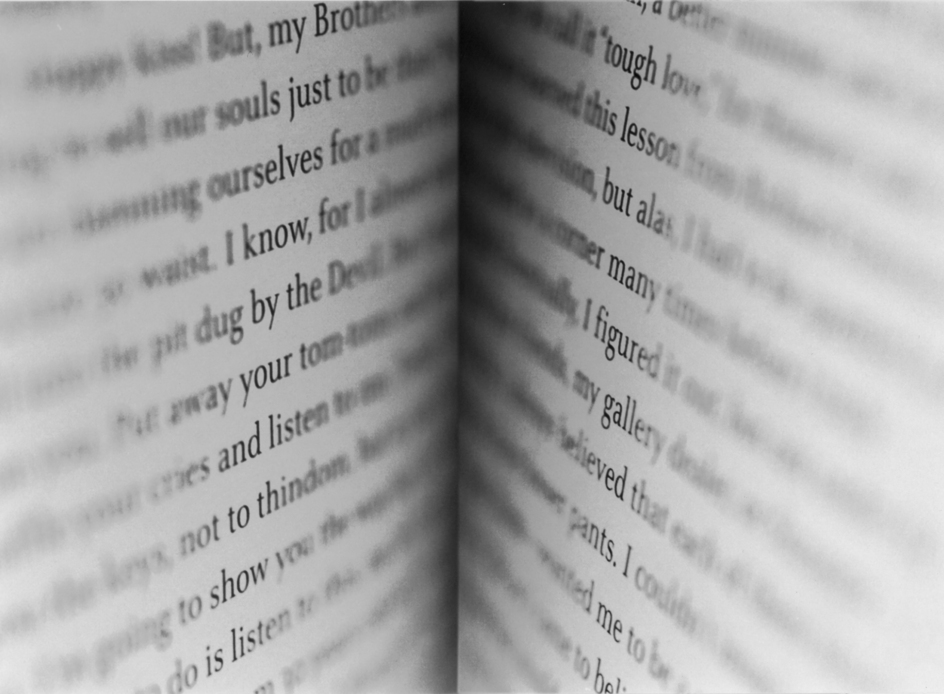
© Holly Kristine Peralta
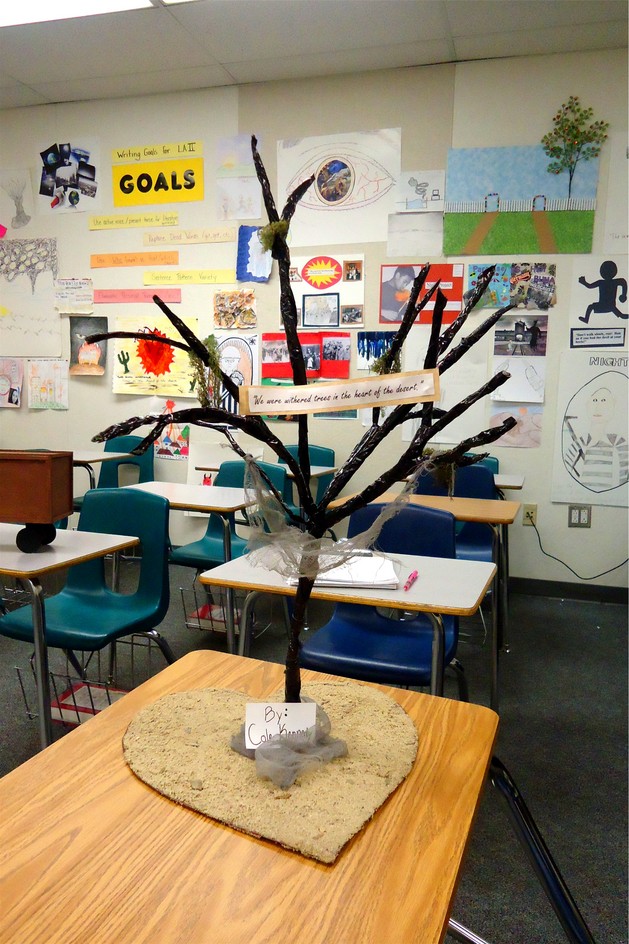
"We were withered trees in the heart of the desert"
From Cole's write-up:
By using a metaphor, the author compares the Jewish prisoners to dried up trees in the middle of the desert. In this quote,Elie Wiesel is explaining how emotionally and physically drained they are in the concentration camps and how they have lost their will to live. With my visual representation, I took on a literal meaning and did a dark and bare tree in the desert. I cut a piece of cardboard into a heart to show that the tree was in the heart of the desert. Also, there is nothing around which shows how empty and alone the prisoners felt when being separated from their loved ones. The inhumane acts of the Nazis killed many people but also took away their motivation to live.
From Cole's write-up:
By using a metaphor, the author compares the Jewish prisoners to dried up trees in the middle of the desert. In this quote,Elie Wiesel is explaining how emotionally and physically drained they are in the concentration camps and how they have lost their will to live. With my visual representation, I took on a literal meaning and did a dark and bare tree in the desert. I cut a piece of cardboard into a heart to show that the tree was in the heart of the desert. Also, there is nothing around which shows how empty and alone the prisoners felt when being separated from their loved ones. The inhumane acts of the Nazis killed many people but also took away their motivation to live.
Cole's visual representation
Figurative Language in Wiesel's Night
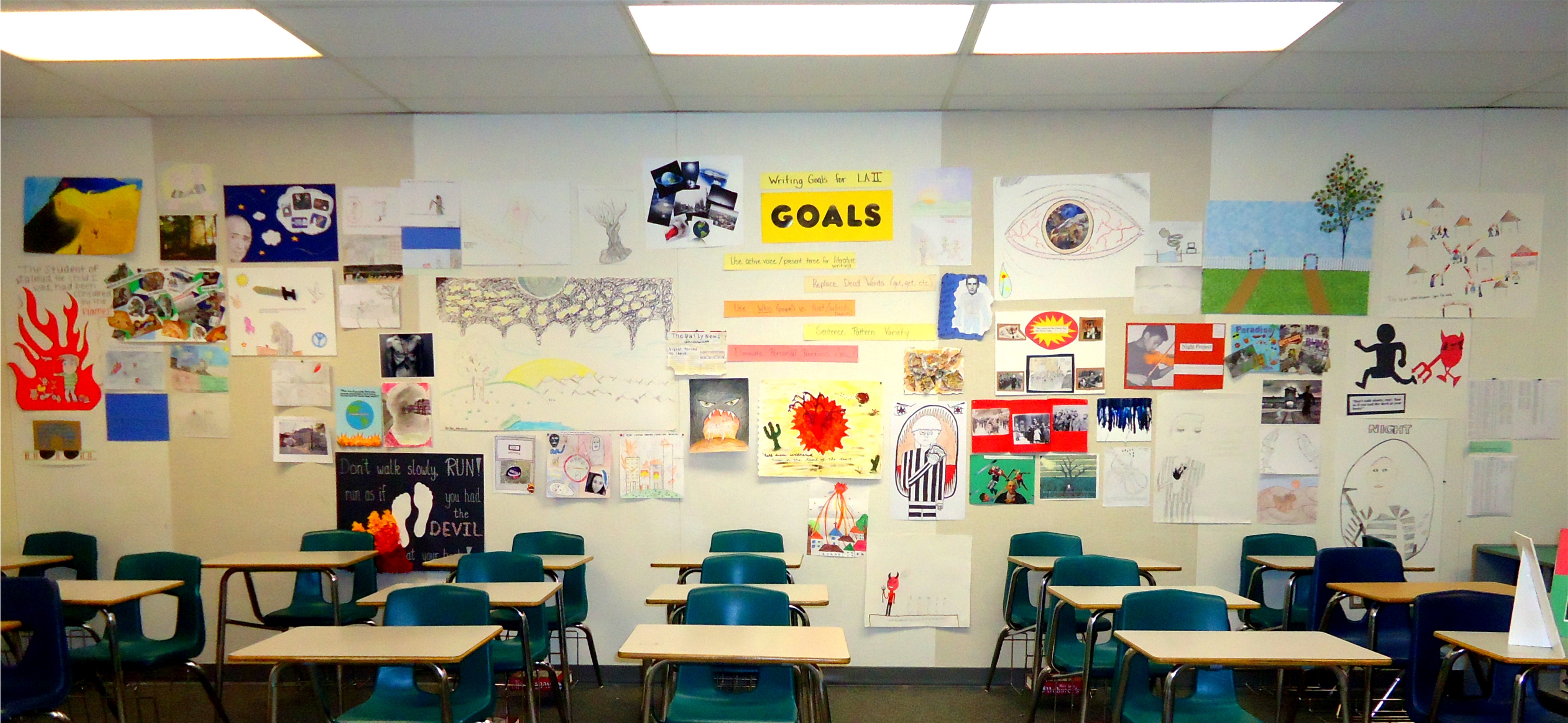 Though Night
is a nonfiction autobiographical account of Elie Wiesel's terrifying ordeal in a concentration
camp during the Holocaust, he employs many artistic devices in order to
clearly and meaningfully convey his experience to the reader.
Though Night
is a nonfiction autobiographical account of Elie Wiesel's terrifying ordeal in a concentration
camp during the Holocaust, he employs many artistic devices in order to
clearly and meaningfully convey his experience to the reader.
I wanted my students to carry away the images of Wiesel's story while simultaneously dealing with the artful language he uses. Students first chose a figurative language line from the book then created a visual representation. The visual could be a literal interpretation or a blend of its literal and figurative meaning. This part of the project allowed students to explore language through hands-on engagement.
Students also submitted a writing component which explicated the line they chose and explained the artistic choices they made - it was this writing portion of the project which were the most impressive. Students truly showed understanding of the line's mechanics, literal and figurative meanings, and association with the rest of the novel. Click here to see the prompt for this project.
California State Standards Fulfilled:
Reading:
1.1 Identify and use the literal and figurative meanings of words.
3.7 Recognize and understand the significance of various literary devices...and explain their appeal.
Writing:
2.2c Demonstrate awareness of the author's use of stylistic devices and an appreciation of the effects created.
 Though Night
is a nonfiction autobiographical account of Elie Wiesel's terrifying ordeal in a concentration
camp during the Holocaust, he employs many artistic devices in order to
clearly and meaningfully convey his experience to the reader.
Though Night
is a nonfiction autobiographical account of Elie Wiesel's terrifying ordeal in a concentration
camp during the Holocaust, he employs many artistic devices in order to
clearly and meaningfully convey his experience to the reader.I wanted my students to carry away the images of Wiesel's story while simultaneously dealing with the artful language he uses. Students first chose a figurative language line from the book then created a visual representation. The visual could be a literal interpretation or a blend of its literal and figurative meaning. This part of the project allowed students to explore language through hands-on engagement.
Students also submitted a writing component which explicated the line they chose and explained the artistic choices they made - it was this writing portion of the project which were the most impressive. Students truly showed understanding of the line's mechanics, literal and figurative meanings, and association with the rest of the novel. Click here to see the prompt for this project.
California State Standards Fulfilled:
Reading:
1.1 Identify and use the literal and figurative meanings of words.
3.7 Recognize and understand the significance of various literary devices...and explain their appeal.
Writing:
2.2c Demonstrate awareness of the author's use of stylistic devices and an appreciation of the effects created.
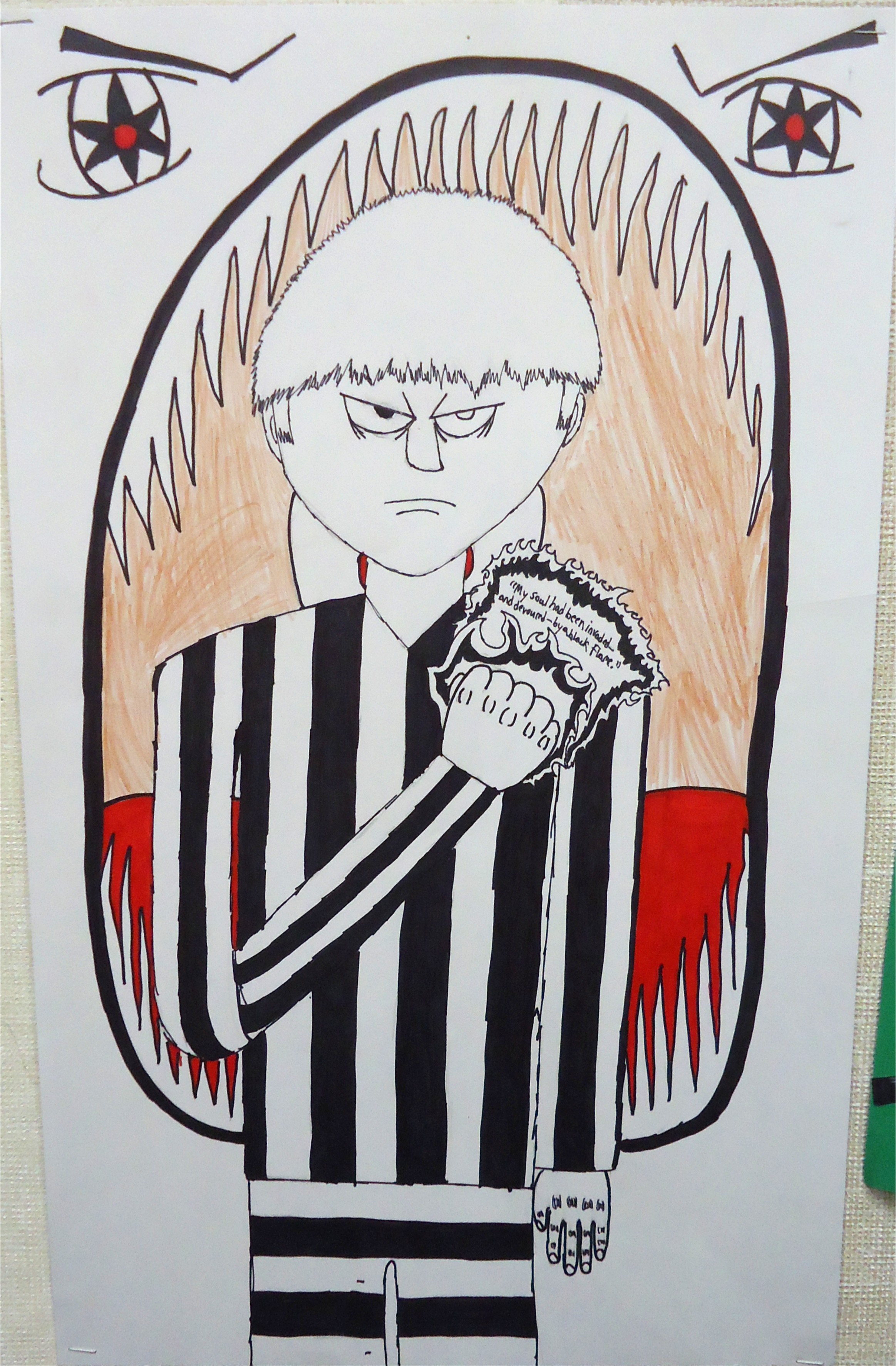
"My soul had been invaded - and devoured - by a black flame."
From Jonathan's write-up:
This line is to be interpreted as a figurative language term, specifically a hyperbole, and the reason is because the sentence uses exaggeration to make the sentence seem more dramatic also it is understandable that what happens in the sentence cannot actually happen. The author is referring to Elie's soul as the main object in this sentence and is acted upon in ways that are unrealistic and impossible...The boy in the visual image represents Elie and his is clutching his soul, which is being "invaded" by the black flames, also there is a dark creature behind him about to "consume" him. The fire and the creature allow for a full grasp of the figurative language line in the fact that it illustrates each action on the soul of Elie very specifically and dramatically...also the face of the boy really gives you a sense of Elie's frustrations and feelings of being abandoned in that specific part of the book.
From Jonathan's write-up:
This line is to be interpreted as a figurative language term, specifically a hyperbole, and the reason is because the sentence uses exaggeration to make the sentence seem more dramatic also it is understandable that what happens in the sentence cannot actually happen. The author is referring to Elie's soul as the main object in this sentence and is acted upon in ways that are unrealistic and impossible...The boy in the visual image represents Elie and his is clutching his soul, which is being "invaded" by the black flames, also there is a dark creature behind him about to "consume" him. The fire and the creature allow for a full grasp of the figurative language line in the fact that it illustrates each action on the soul of Elie very specifically and dramatically...also the face of the boy really gives you a sense of Elie's frustrations and feelings of being abandoned in that specific part of the book.
Jonathan's visual representation
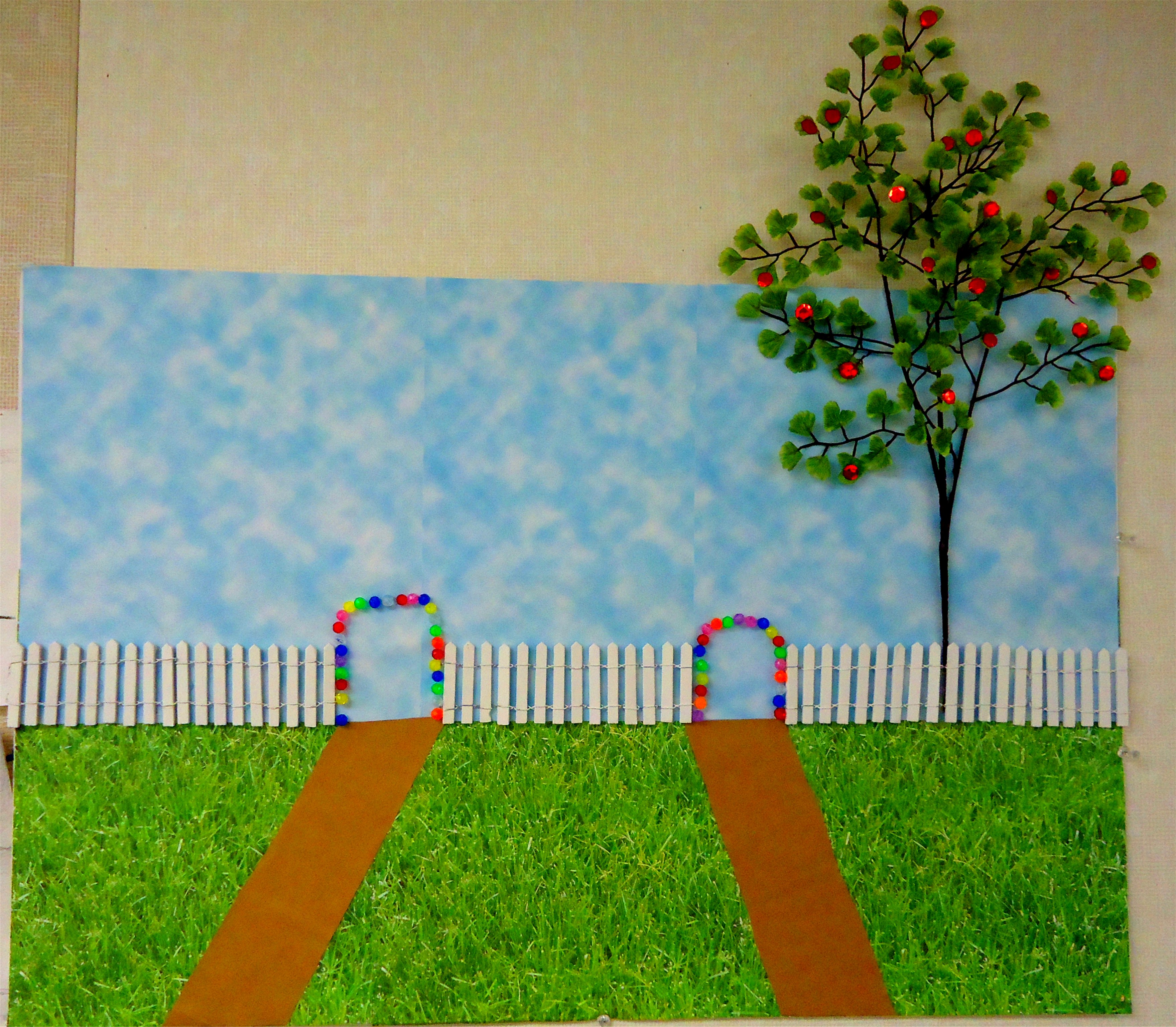
"There are a thousand and one gates allowing entry into the orchard of mystical truth. Every human being has his own gate."
From Jane's write-up:
The figurative language in this quote is symbolism. The orchard of mystical truth symbolizes heaven and each person having their own gate a symbolizes the need for each person to go through their own journey to reach heaven. The words "a thousand and one gates" helps the reader think of a big, beautiful place. The phrase "mystical truth" gives the impression that one's prayers and questions will be answered. The verb "allowing: symbolizes that not anyone can enter, one must complete certain requirements to enter, that the orchard has power.
From Jane's write-up:
The figurative language in this quote is symbolism. The orchard of mystical truth symbolizes heaven and each person having their own gate a symbolizes the need for each person to go through their own journey to reach heaven. The words "a thousand and one gates" helps the reader think of a big, beautiful place. The phrase "mystical truth" gives the impression that one's prayers and questions will be answered. The verb "allowing: symbolizes that not anyone can enter, one must complete certain requirements to enter, that the orchard has power.
Jane's visual representation
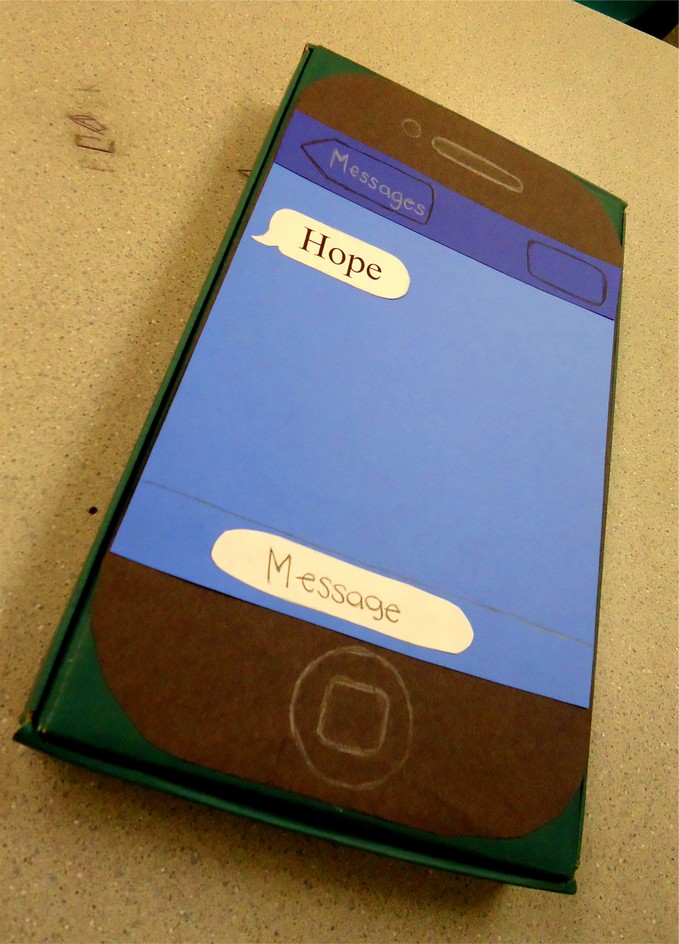
"Every one of his words was healing and every glance of his carried a message of hope."
From Liz's write-up:
Elie seems to admire every motion and expression from the doctor. This was important for both of them because Elie was going to be awake during surgery so they need to gain trust for each other...To represent this line I put a modern twist on it and made a 3-dimensional iPhone. The iPhone shows a text message that says, "hope" on it much like how Elie receives hope from his doctor. On the back of the iPhone's cover is the word, "healing" repeatedly. This shows how we feel safe with our phone because of how dependent we are on technology today, but for Elie these two simple words were his way of trust and to believe he would be fine.
From Liz's write-up:
Elie seems to admire every motion and expression from the doctor. This was important for both of them because Elie was going to be awake during surgery so they need to gain trust for each other...To represent this line I put a modern twist on it and made a 3-dimensional iPhone. The iPhone shows a text message that says, "hope" on it much like how Elie receives hope from his doctor. On the back of the iPhone's cover is the word, "healing" repeatedly. This shows how we feel safe with our phone because of how dependent we are on technology today, but for Elie these two simple words were his way of trust and to believe he would be fine.
Liz's visual representation
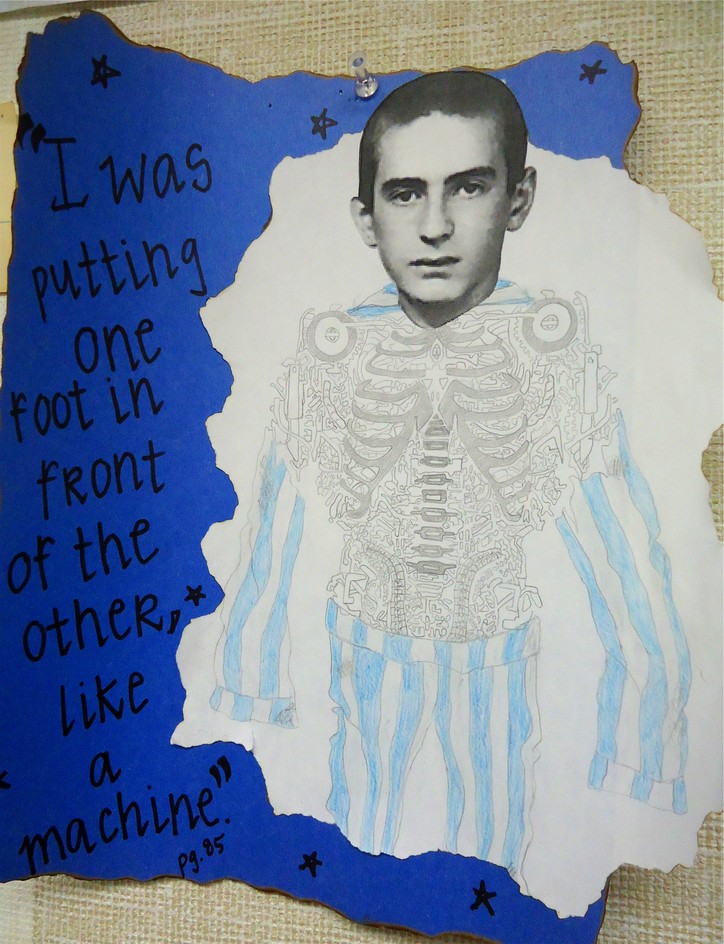
Karsyn's visual representation
"I was putting one foot in front of the other, like a machine."
From Karsyn's write-up:
This line is an example of a simile because he does not say he is a machine, he says he resembles one...By stating that he was putting one foot in front of the other, he is symbolizing how he feels throughout his journey, which is taking everything one step at a time. By making himself a synonym to the object of a machine, he was making it clear that he was not in control of his own body...The visual representation of this quote is the literal meaning, which would be that Elie is a machine, without a heart or a brain. Elie's body has no skin, blood, or bones. His body is held together entirely of metal screws. His head is a picture of him when he was 15-years-old, which was the same year he was sent to Auschwitz. he is wearing blue striped pajamas, which was the only clothing provided at the camps. The background is blue and there are stars representing the sky...He is dressed in workers clothes to remind the reader that he was stripped of his individuality the day he arrived at Auschwitz. He was now only a number and identical to all of the other prisoners, also similar to machines because they have no personality and are identical to all others of their kind.
From Karsyn's write-up:
This line is an example of a simile because he does not say he is a machine, he says he resembles one...By stating that he was putting one foot in front of the other, he is symbolizing how he feels throughout his journey, which is taking everything one step at a time. By making himself a synonym to the object of a machine, he was making it clear that he was not in control of his own body...The visual representation of this quote is the literal meaning, which would be that Elie is a machine, without a heart or a brain. Elie's body has no skin, blood, or bones. His body is held together entirely of metal screws. His head is a picture of him when he was 15-years-old, which was the same year he was sent to Auschwitz. he is wearing blue striped pajamas, which was the only clothing provided at the camps. The background is blue and there are stars representing the sky...He is dressed in workers clothes to remind the reader that he was stripped of his individuality the day he arrived at Auschwitz. He was now only a number and identical to all of the other prisoners, also similar to machines because they have no personality and are identical to all others of their kind.
"'For God's sake, where is God?' and from within me, I heard a voice answer: Where He is? This is where - hanging from these gallows."
From Lauren's write-up:
The inmates have gone so far and seen so much, but to watch as an angelic chil hangs, still breathing from the gallows, that was too much for most. God cannot help them as God is also dead...To get this quote across with emotion, I have chosen to use photographs. My blonde friend acted as a model and we ventured out to a wetland area that could resemble the grounds of Auschwitz...The air around him glows as if to represent lights from heaven.
From Lauren's write-up:
The inmates have gone so far and seen so much, but to watch as an angelic chil hangs, still breathing from the gallows, that was too much for most. God cannot help them as God is also dead...To get this quote across with emotion, I have chosen to use photographs. My blonde friend acted as a model and we ventured out to a wetland area that could resemble the grounds of Auschwitz...The air around him glows as if to represent lights from heaven.
Lauren's visual representation
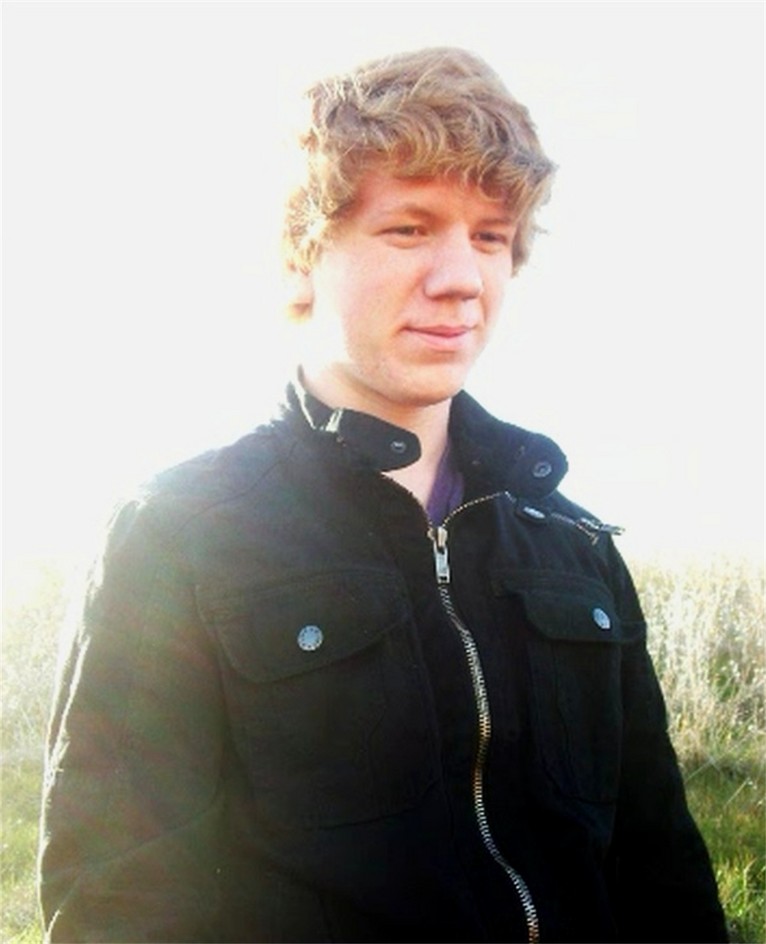
The classroom wall covered with the 2D projects.
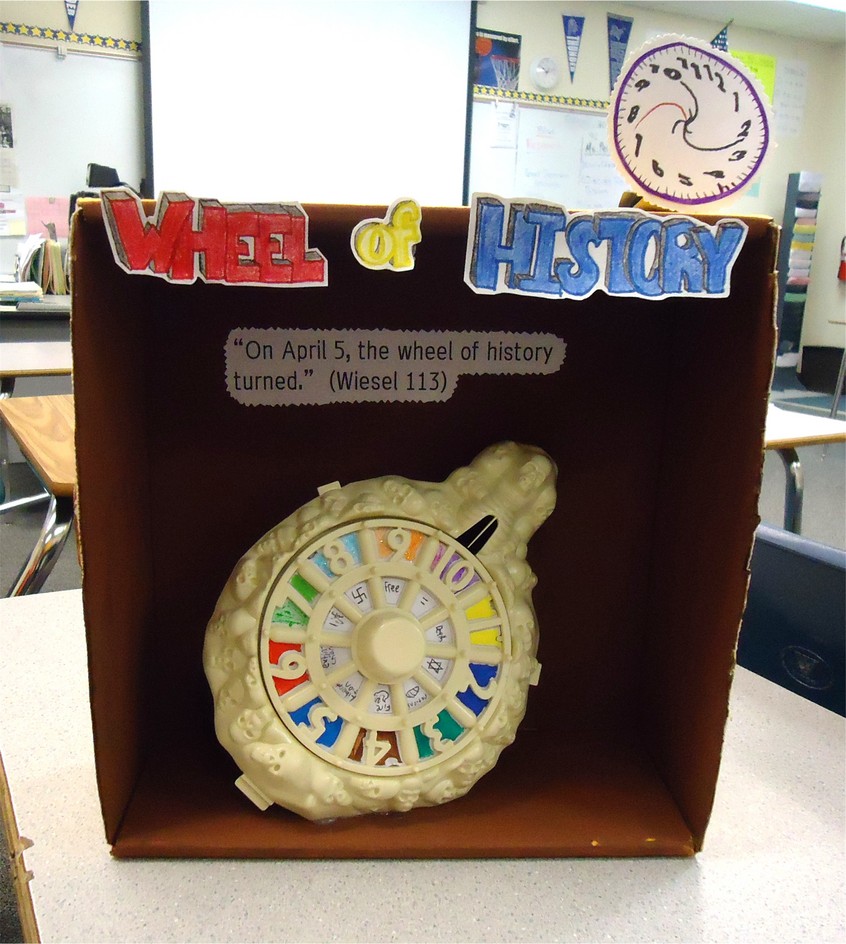
"On April 5th, the wheel of history turned."
From Daniel's write-up:
This quote is a metaphor because it is comparing a change in their fates to a literal wheel of history. This representation works very well because it is a wheel with many destinies. When he refers to the wheel of history turning, he is talking about their fortunes taking a turn for the better. The front is drawing near to their camp and they are about the be liberated...For my representation I did a shoebox diagram with a wheel with some possible outcomes for Elie in it. They included such symbols as life, death, liberation, equality. I chose to make this project creepy yet flashy. I wanted to make it like a twisted sort of demonic game board. I made sure the skulls pointed out the macabre and what is at stake there.
From Daniel's write-up:
This quote is a metaphor because it is comparing a change in their fates to a literal wheel of history. This representation works very well because it is a wheel with many destinies. When he refers to the wheel of history turning, he is talking about their fortunes taking a turn for the better. The front is drawing near to their camp and they are about the be liberated...For my representation I did a shoebox diagram with a wheel with some possible outcomes for Elie in it. They included such symbols as life, death, liberation, equality. I chose to make this project creepy yet flashy. I wanted to make it like a twisted sort of demonic game board. I made sure the skulls pointed out the macabre and what is at stake there.
Daniel's visual representation
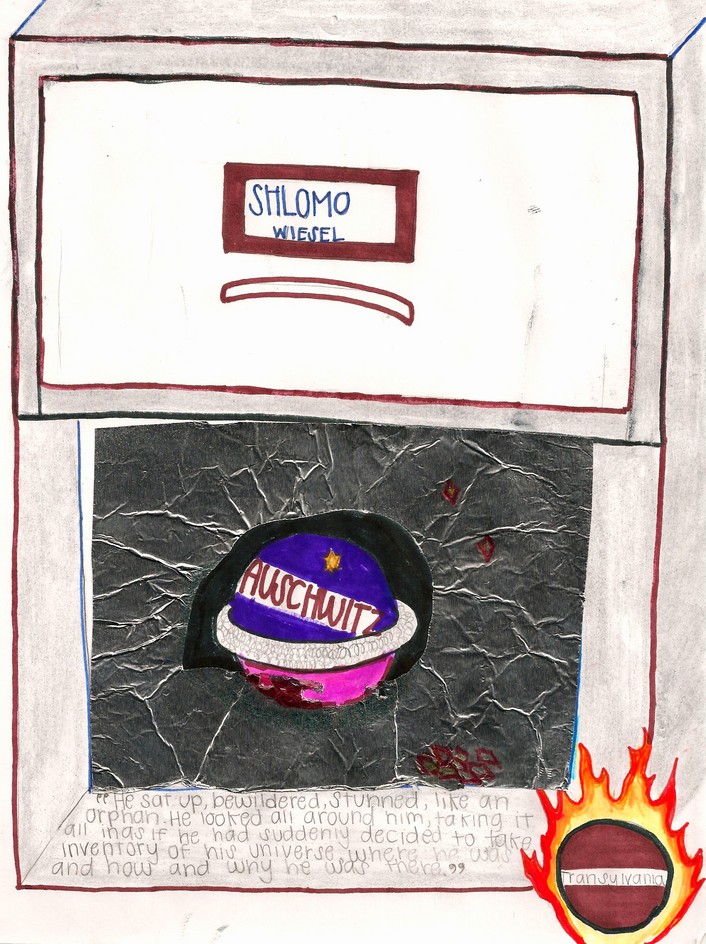
"He sat up, bewildered, stunned, like an orphan...he had suddenly decided to take inventory of his universe, where he was and how and why he was there."
From Jenna's write-up:
The author uses varied forms of figurative language to help explain the change of mind occurring within his father. These forms of figurative language are hyperbole and simile. By stating, "inventory of the universe," it is hyperbole because it is not as literal of a meaning, and he is exaggerating what is occurring in his father's mind. Also, Elie used simile to compare him to an orphan. By calling Shlomo an orphan, Elie is showing that Shlomo has minimal understanding of what is occurring and that he is frightened at first. By the use of multiple commas in each line, the words are given more importance due to an increased amount of pauses...The entire drawing is a file cabinet titled SHLOMO WIESEL and it is inventory of the universe in Shlomo's life and everything that has occurred. The line "how and why he was there" is demonstrated by the large planet of Auschwitz in the center of the picture. The planet shows how the concentration camp, Auschwitz, has taken over the world, which is also exhibited by the burning stars and planet of Transylvania. The burning stars represent the people of the concentration camp and their slow loss of hope in the world. Also, the stars represent the light of Shlomo's world, which is slowly burning out.
From Jenna's write-up:
The author uses varied forms of figurative language to help explain the change of mind occurring within his father. These forms of figurative language are hyperbole and simile. By stating, "inventory of the universe," it is hyperbole because it is not as literal of a meaning, and he is exaggerating what is occurring in his father's mind. Also, Elie used simile to compare him to an orphan. By calling Shlomo an orphan, Elie is showing that Shlomo has minimal understanding of what is occurring and that he is frightened at first. By the use of multiple commas in each line, the words are given more importance due to an increased amount of pauses...The entire drawing is a file cabinet titled SHLOMO WIESEL and it is inventory of the universe in Shlomo's life and everything that has occurred. The line "how and why he was there" is demonstrated by the large planet of Auschwitz in the center of the picture. The planet shows how the concentration camp, Auschwitz, has taken over the world, which is also exhibited by the burning stars and planet of Transylvania. The burning stars represent the people of the concentration camp and their slow loss of hope in the world. Also, the stars represent the light of Shlomo's world, which is slowly burning out.
Jenna's visual representation
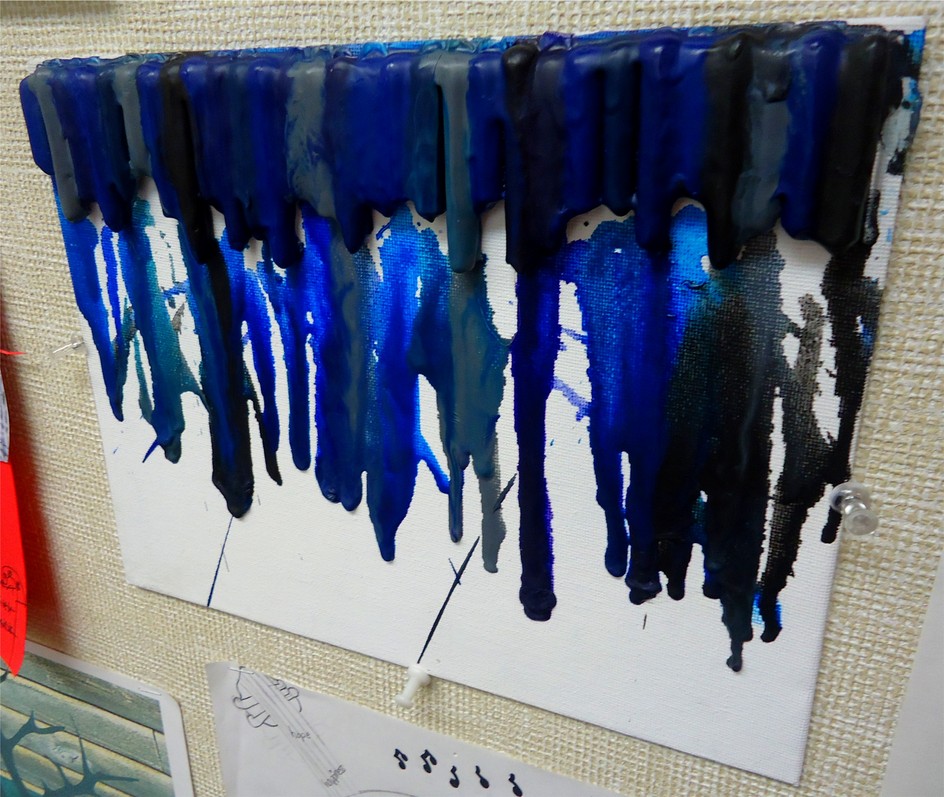
"Night was falling rapidly."
From Alexa's write-up:
The line uses symbolism as the term "night" has a much deeper meaning than just the time between sunset and sunrise. Wiesel uses the word "night" to help describe the period of time of injustice, when the jews were suppressed and persecuted by the Nazis. During that time, the Jews felt as if they were living in a world of darkness, without any light or hope...The crayons aligned at the top of the canvas represent the night as the crayons' wax is quickly dripping down the canvas, filling the white, open space with darkness. The blank canvas was once free and full of potential, just like the Jews all over Europe. However it is now quickly being over taken by the dark wax, similar to the way the Nazis spread throughout Europe. At first, the crayons seem insignificant and off in the distance, similar to the way the people of Sighet felt about the Nazis.
From Alexa's write-up:
The line uses symbolism as the term "night" has a much deeper meaning than just the time between sunset and sunrise. Wiesel uses the word "night" to help describe the period of time of injustice, when the jews were suppressed and persecuted by the Nazis. During that time, the Jews felt as if they were living in a world of darkness, without any light or hope...The crayons aligned at the top of the canvas represent the night as the crayons' wax is quickly dripping down the canvas, filling the white, open space with darkness. The blank canvas was once free and full of potential, just like the Jews all over Europe. However it is now quickly being over taken by the dark wax, similar to the way the Nazis spread throughout Europe. At first, the crayons seem insignificant and off in the distance, similar to the way the people of Sighet felt about the Nazis.
Alexa's visual representation

"I hated that bell. Whenever I happened to dream of a better world, I imagined a universe without a bell."
From Jaymi's write-up:
The figurative language used in this example is symbolism because the bell is a symbol of how cruelly the Germans treated Jews in the concentration camps. He loathed the bell because it was a tool that the people torturing him everyday used to order him around...My visual aid shows Elie Wiesel dreaming about places that usually have bells, but imagining the bells as invisible. The poster is dark with stars and sparkly waves to represent the universe Elie describes in his dream. Inside the thought bubble are familiar scenes with bells removed. By removing the bells, I am symbolizing the elimination of all the horrible aspects of Elie's life.
From Jaymi's write-up:
The figurative language used in this example is symbolism because the bell is a symbol of how cruelly the Germans treated Jews in the concentration camps. He loathed the bell because it was a tool that the people torturing him everyday used to order him around...My visual aid shows Elie Wiesel dreaming about places that usually have bells, but imagining the bells as invisible. The poster is dark with stars and sparkly waves to represent the universe Elie describes in his dream. Inside the thought bubble are familiar scenes with bells removed. By removing the bells, I am symbolizing the elimination of all the horrible aspects of Elie's life.
Jaymi's visual representation